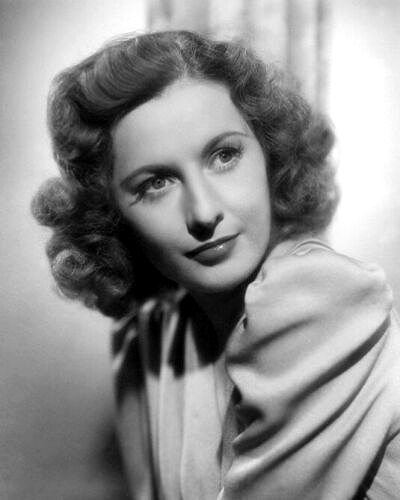Barbara Stanwyck: Difference between revisions - Wikipedia
 Article Images
Article Images
Content deleted Content added
Tags: harv-error Visual edit |
|||
| (7 intermediate revisions by 7 users not shown) | |||
Line 47: ===Ziegfeld girl and Broadway success=== [[File:Barbara Stanwyck, Ziegfeld girl, by Alfred Cheney Johnston, ca. 1924.jpg|thumb|Stanwyck as a Ziegfeld girl in a 1924 photo by [[Alfred Cheney Johnston]]|alt=]] In 1923, a few months before her 16th birthday, Ruby auditioned for a place in the chorus at the Strand Roof, a [[nightclub]] over the [[Mark Strand Theatre|Strand Theatre]] in [[Times Square]].<ref>Madsen 1994, p. 13.</ref> A few months later, she obtained a job as a dancer in the 1922 and 1923 seasons of the [[Ziegfeld Follies]], dancing at the [[New Amsterdam Theater]]. "I just wanted to survive and eat and have a nice coat", Stanwyck said.<ref name=Callahan>Callahan 2012, p. 9.</ref><ref name="Prono241">Prono 2008, p. 241.</ref> For the next several years, she worked as a chorus girl, performing from midnight to seven Billy LaHiff, who owned a popular pub frequented by showpeople, introduced Ruby in 1926 to [[impresario]] [[Willard Mack]].<ref>Madsen 1994, p. 21.</ref> Mack was casting his play ''[[The Noose (play)|The Noose]]'', and LaHiff suggested that the part of the chorus girl be played by a real one. Mack agreed, and after a successful audition gave the part to Ruby.<ref>Madsen 1994, p. 22.</ref> She co-starred with [[Rex Cherryman]] and [[Wilfred Lucas]].<ref>Wayne 2009, p. 17.</ref> As initially staged, the play was not a success.<ref name="M26" /> In an effort to improve it, Mack decided to expand Ruby's part to include more pathos.<ref>Madsen 1994, p. 25.</ref> ''The Noose'' re-opened on October 20, 1926, and became one of the most successful plays of the season, running on [[Broadway theatre|Broadway]] for nine months and 197 performances.<ref name="Prono241" /> At the suggestion of [[David Belasco]], Ruby changed her name to Barbara Stanwyck by combining the first name of the title character in the play ''[[Barbara Frietchie]]'' with the last name of the actress in the play, Jane Stanwyck; both were found on a 1906 theater program.<ref name="M26">Madsen 1994, p. 26.</ref><ref>{{Cite book|url=https://books.google.com/books?id=IEnwCgAAQBAJ&q=barbara+stanwyck+in+barbara+frietchie+play&pg=PA999|title=A Life of Barbara Stanwyck: Steel-True 1907–1940|last=Wilson|first=Victoria|date=November 24, 2015|publisher=Simon and Schuster|isbn=9781439194065|language=en}}</ref> Line 113: [[File:Barbara Stanwyck in 'East Side, West Side', 1949.jpg|right|thumb|Magazine ad for [[East Side, West Side (1949 film)|''East Side West Side'']] (1949) starring Stanwyck, [[James Mason]] and [[Ava Gardner]]]] Stanwyck and Taylor Stanwyck was one of the best-liked actresses in Hollywood and maintained friendships with many of her fellow actors (as well as crew members of her films and TV shows), including [[Joel McCrea]] and his wife [[Frances Dee]], [[George Brent]], [[Robert Preston (actor)|Robert Preston]], [[Henry Fonda]] (who had a longtime crush on her),<ref>{{Cite news|url=https://www.dametown.com/what-would-barbara-stanwyck-do/|title=What Would Barbara Stanwyck Do? |newspaper=Dametown|date=February 22, 2013 |language=en-US|access-date=May 17, 2018 |last1=Laite |first1=Dixie }}</ref><ref>{{Cite news|url=https://classicforareason.com/2017/03/28/the-lady-eve/|title=The Lady Eve|date=March 28, 2017|work=Classic for a Reason|access-date=May 17, 2018|language=en-US}}</ref> [[James Stewart]], [[Linda Evans]], [[Joan Crawford]], [[Jack Benny]] and his wife [[Mary Livingstone]], [[William Holden]], [[Gary Cooper]], and [[Fred MacMurray]].<ref>Wayne 2009, pp. 146, 166.</ref> During filming of ''[[To Please a Lady]]'', Stanwyck refused to leave her African-American maid Harriet Coray in a hotel only for African-American people and insisted that Harriet stay in the same hotel as she did. After much pressure from Stanwyck, Coray was allowed to stay in the best hotel in Indianapolis with Stanwyck and the rest of the cast and crew.<ref>Movie Anecdotes; Peter Hay, 1990.</ref> Stanwyck, at age 45, had a four-year romantic affair with 22-year-old actor [[Robert Wagner]] that had begun on the set of ''[[Titanic (1953 film)|Titanic]]'' (1953)<ref>{{Cite book|last=Wagner|first=Robert|title=I Loved Her in the Movies|publisher=Viking|year=2016|isbn=9780525429111|location=New York, NY|pages=124}}</ref> before Stanwyck ended the relationship.<ref>King, Susan. "Wagner Memoir Tells of Wood Death, Stanwyck Affair". ''San Jose Mercury News'' (California) October 5, 2008, p. 6D. Retrieved: via ''Access World News'': June 16, 2009.</ref> The affair is described in Wagner's 2008 memoir ''Pieces of My Heart''.<ref>Wagner and Eyman 2008, p. 64 ===Political views=== Line 141: ==Filmography== {{Main|Barbara Stanwyck on stage, screen, radio and television}} Forbidden movie 1932 ==Awards and nominations== Line 304 ⟶ 305: * Wayne, Jane. ''Life and Loves of Barbara Stanwyck''. London: JR Books Ltd, 2009. {{ISBN|978-1-906217-94-5}}. * {{Cite book|last=Wayne|first=Jane Ellen|url=https://archive.org/details/stanwyck00wayn|url-access=registration|title=Stanwyck|year=1985|publisher=[[Arbor House]]|isbn=0-87795-750-9|oclc=12371482}} * {{Refend}} Line 321 ⟶ 322: * [http://www.virtual-history.com/movie/person/910/barbara-stanwyck Barbara Stanwyck] at Virtual History * [https://web.archive.org/web/20101030120608/http://www.time.com/time/arts/article/0,8599,170907,00.html That Old Feeling: Ruby in the Rough] and [https://web.archive.org/web/20101030135202/http://www.time.com/time/arts/article/0,8599,171778,00.html The Four Phases of Eve] by Richard Corliss for ''Time'' magazine, 2001 * [ * [http://www.newyorker.com/reporting/2007/04/30/070430fa_fact_lane Lady Be Good – A centenary season of Barbara Stanwyck] by Anthony Lane for ''The New Yorker'', 2007 * {{IMdb name|828260|Bert Stevens}} | |||